Time to get dirty again folks! 
Changing the oils in the gearbox (also referred to as ‘the transmission’) is a whole lot easier if you have access to a pit, but it’s easy enough to do it without, so not to worry. There is plenty of room for you to lie on the ground under the vehicle to access the drain and filler plugs, but REMEMBER, always apply the handbrake, chock the wheels, and remove the keys from the ignition.
First off, you need to buy 2 gallons of EP90 gear oil (stick to EP90 and not EP80/90, as EP90 is what is recommended for the Land Rover transmission. 80/90 is a slightly different oil and may not be completely suitable for the bearings in the series gearbox), and also a 500ml bottle of oil with a flexible spout. The two gallons will be enough oil to change the main gearbox, transfer box, and overdrive (if fitted), and will leave enough remaining to change the oil in the differentials and front swivel housings (which will be dealt with separately).
There are a few minor differences between the SII/IIa and III gearboxes as fitted to 2.25 litre engines, but the main points are the same. The photos used in this article are of a late SIII gearbox, so they might differ slightly from your own gearbox.
To business… from under the vehicle, locate the main gearbox drain plug and filler plug. (Loosen the filler plug before you start, this has two benefits...it allows the oil to drain out faster, and also shows you that you can put oil back in afterwards!)

Then, having placed a suitable container underneath to catch the draining oil, loosen the brass nut and then remove it, keeping pressure on the nut. When the nut is undone, remove it quickly, and hopefully you should avoid getting old EP90 running down your arm! You can examine the oil after draining it; hopefully there should be no big chunks of metal in it, though you will probably find small flakes of metal which are the result of all those times ‘somebody’ crunched the gears, and of general wear and tear. Don’t be too worried!
Once the oil has finished draining, replace the drain/sump plug. I usually put a light smear of instant gasket on the last few threads of the plug to be sure of a good seal, but don’t forget to replace the copper washer with the plug if there was one on there when you took it out. Then, remove the filler/level plug:
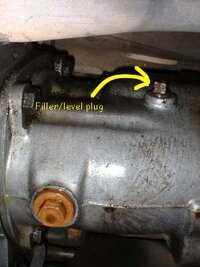
An adjustable spanner is the ideal tool for this. The main box will take approximately 2.5 pints of oil (1.5 litres) and you may find that getting the oil into the filler aperture is, well, interesting. It’s in an awkward place between the chassis and the body work…… This is where the bottle with the flexible spout comes in handy. A 500ml bottle is just about the right size to fit in, but it’s still awkward. I personally use a home made device, made from a big tomato ketchup pump which fits on the gallon container and a length of flexible tubing:

Once the gearbox is full, the oil will start to come back out of the filler aperture; now you can replace the filler plug. Remember, you can check the oil level in the gearbox at any time by removing this plug….just allow time for the oil to settle after a run….and top it up as necessary.
The transfer box is filled and checked in very much the same manner as the main gearbox. Loosen the filler plug, then remove the drain plug:
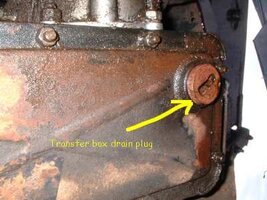
You will notice the drain plug has a slot rather than a hexagonal nut for removal, and to undo this I use an old spanner which has been cut in half, the cut end of which fits into the slot. I turn the spanner using the trusty adjustable spanner! Allow the oil to drain from the transfer box into your container. Whilst the oil is draining you can spend a wee bit of time checking that the bolts holding the base of the transfer box are secure, as this is a source of a good few oil leaks! Once the oil has finished draining, replace the drain/sump plug, and remove the filler/level plug, which you loosened earlier, of course!
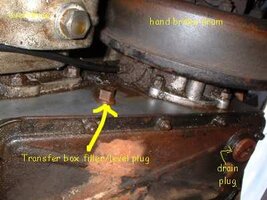
Start to fill with oil until it again appears at the bottom of the filler aperture. This should take approximately 4.5 pints (2.5 litres). Replace the filler plug.
when checking the level of the oil in the transfer box, you may find after time that there is a lot more oil in there than there really should be, and oil will pour out when you remove the filler plug. This is a common problem, due to migration of oil from the main gearbox into the transfer box, and if happens to you, do not be too worried. You must however make sure that you check the oil levels regularly in the main box, to make sure it is not too empty, and also the transfer box to make sure it is not too full, as the resultant pressure created by the extra oil can lead to blown oil seals. Keep an eye on it though, and things should be okay.
The overdrive fitted most commonly to series Land Rovers is the ‘Fairey’ overdrive. There are different makes though, so reference should be made to individual manufacturers’ literature if at all possible for the correct oil capacities for these. This section deals with the procedure for changing the oil in a Fairey overdrive.
Remove the drain plug at the bottom of the O/D:
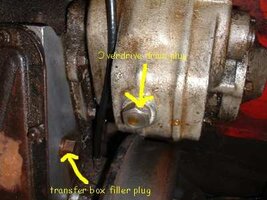
Drain the oil into your container. Refit the drain plug (again a wee smear of instant gasket will not go amiss here) then remove the filler plug, which is accessed from inside the vehicle, underneath the centre seat (or cubby box if you have one):
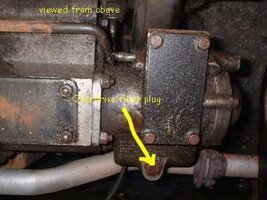
The filler plug usually has a dipstick attached with the correct level marked:
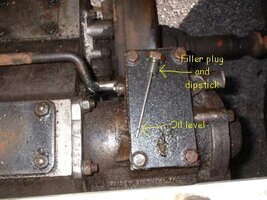
But in any case, the overdrive should hold 3/4 pint (0.4 litres) of EP90.
That’s it done! Transmission oils changed ... things should run a bit quieter now!
Changing the oils in the gearbox (also referred to as ‘the transmission’) is a whole lot easier if you have access to a pit, but it’s easy enough to do it without, so not to worry. There is plenty of room for you to lie on the ground under the vehicle to access the drain and filler plugs, but REMEMBER, always apply the handbrake, chock the wheels, and remove the keys from the ignition.
First off, you need to buy 2 gallons of EP90 gear oil (stick to EP90 and not EP80/90, as EP90 is what is recommended for the Land Rover transmission. 80/90 is a slightly different oil and may not be completely suitable for the bearings in the series gearbox), and also a 500ml bottle of oil with a flexible spout. The two gallons will be enough oil to change the main gearbox, transfer box, and overdrive (if fitted), and will leave enough remaining to change the oil in the differentials and front swivel housings (which will be dealt with separately).
There are a few minor differences between the SII/IIa and III gearboxes as fitted to 2.25 litre engines, but the main points are the same. The photos used in this article are of a late SIII gearbox, so they might differ slightly from your own gearbox.
To business… from under the vehicle, locate the main gearbox drain plug and filler plug. (Loosen the filler plug before you start, this has two benefits...it allows the oil to drain out faster, and also shows you that you can put oil back in afterwards!)

Then, having placed a suitable container underneath to catch the draining oil, loosen the brass nut and then remove it, keeping pressure on the nut. When the nut is undone, remove it quickly, and hopefully you should avoid getting old EP90 running down your arm! You can examine the oil after draining it; hopefully there should be no big chunks of metal in it, though you will probably find small flakes of metal which are the result of all those times ‘somebody’ crunched the gears, and of general wear and tear. Don’t be too worried!
Once the oil has finished draining, replace the drain/sump plug. I usually put a light smear of instant gasket on the last few threads of the plug to be sure of a good seal, but don’t forget to replace the copper washer with the plug if there was one on there when you took it out. Then, remove the filler/level plug:

An adjustable spanner is the ideal tool for this. The main box will take approximately 2.5 pints of oil (1.5 litres) and you may find that getting the oil into the filler aperture is, well, interesting. It’s in an awkward place between the chassis and the body work…… This is where the bottle with the flexible spout comes in handy. A 500ml bottle is just about the right size to fit in, but it’s still awkward. I personally use a home made device, made from a big tomato ketchup pump which fits on the gallon container and a length of flexible tubing:

Once the gearbox is full, the oil will start to come back out of the filler aperture; now you can replace the filler plug. Remember, you can check the oil level in the gearbox at any time by removing this plug….just allow time for the oil to settle after a run….and top it up as necessary.
The transfer box is filled and checked in very much the same manner as the main gearbox. Loosen the filler plug, then remove the drain plug:

You will notice the drain plug has a slot rather than a hexagonal nut for removal, and to undo this I use an old spanner which has been cut in half, the cut end of which fits into the slot. I turn the spanner using the trusty adjustable spanner! Allow the oil to drain from the transfer box into your container. Whilst the oil is draining you can spend a wee bit of time checking that the bolts holding the base of the transfer box are secure, as this is a source of a good few oil leaks! Once the oil has finished draining, replace the drain/sump plug, and remove the filler/level plug, which you loosened earlier, of course!

Start to fill with oil until it again appears at the bottom of the filler aperture. This should take approximately 4.5 pints (2.5 litres). Replace the filler plug.
when checking the level of the oil in the transfer box, you may find after time that there is a lot more oil in there than there really should be, and oil will pour out when you remove the filler plug. This is a common problem, due to migration of oil from the main gearbox into the transfer box, and if happens to you, do not be too worried. You must however make sure that you check the oil levels regularly in the main box, to make sure it is not too empty, and also the transfer box to make sure it is not too full, as the resultant pressure created by the extra oil can lead to blown oil seals. Keep an eye on it though, and things should be okay.
The overdrive fitted most commonly to series Land Rovers is the ‘Fairey’ overdrive. There are different makes though, so reference should be made to individual manufacturers’ literature if at all possible for the correct oil capacities for these. This section deals with the procedure for changing the oil in a Fairey overdrive.
Remove the drain plug at the bottom of the O/D:

Drain the oil into your container. Refit the drain plug (again a wee smear of instant gasket will not go amiss here) then remove the filler plug, which is accessed from inside the vehicle, underneath the centre seat (or cubby box if you have one):

The filler plug usually has a dipstick attached with the correct level marked:

But in any case, the overdrive should hold 3/4 pint (0.4 litres) of EP90.
That’s it done! Transmission oils changed ... things should run a bit quieter now!
